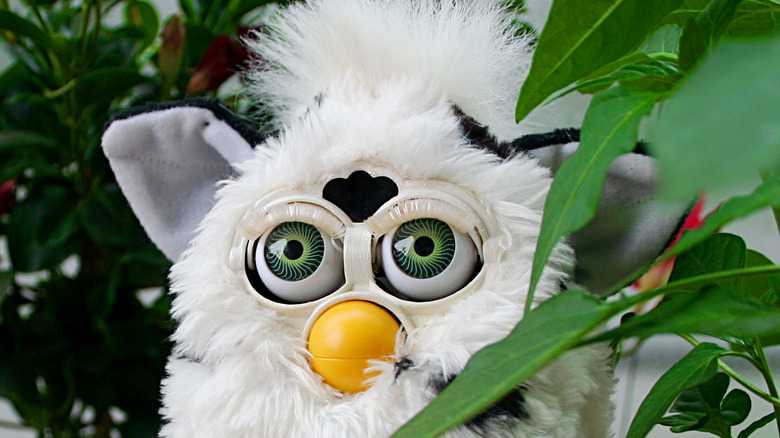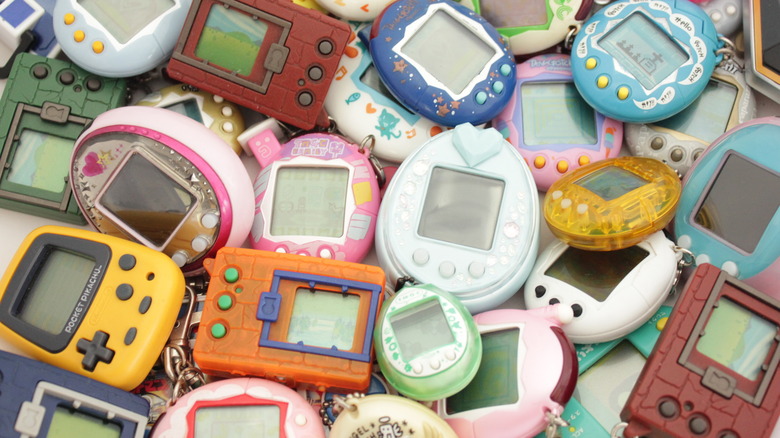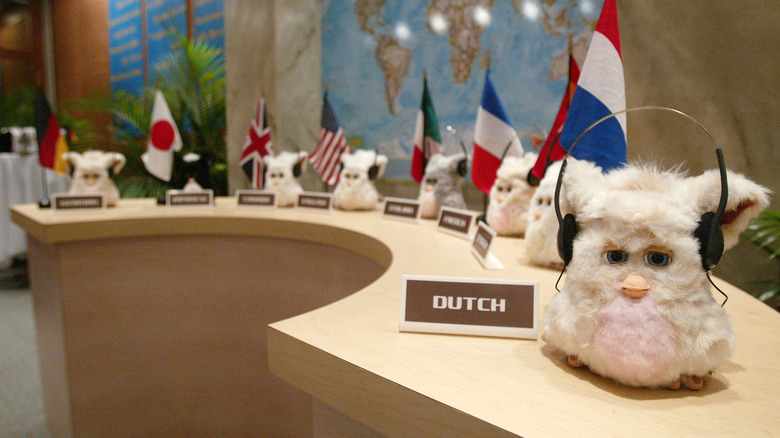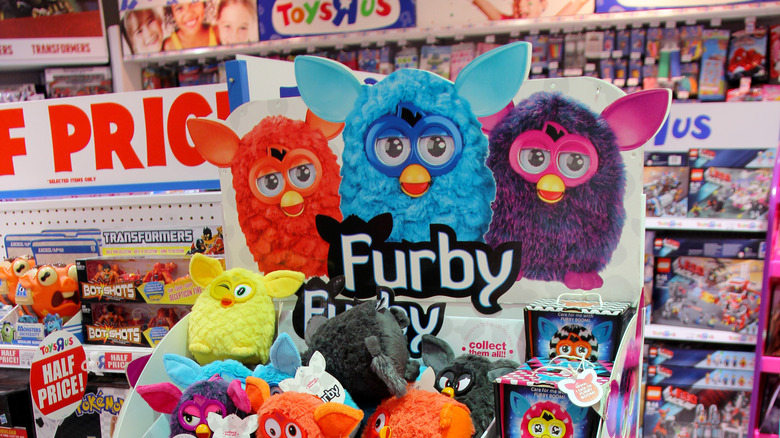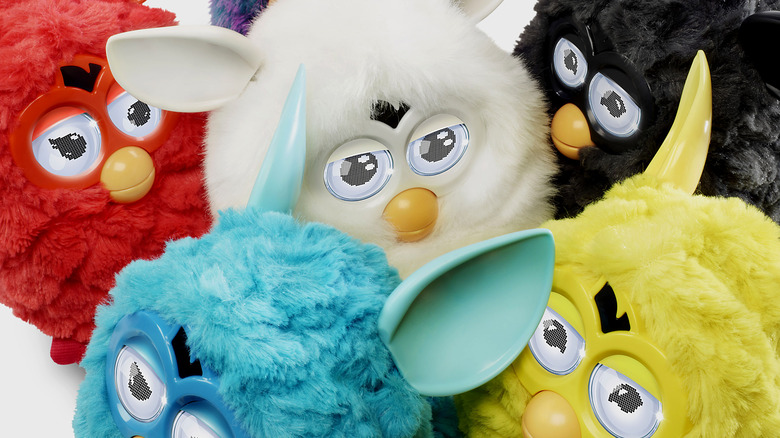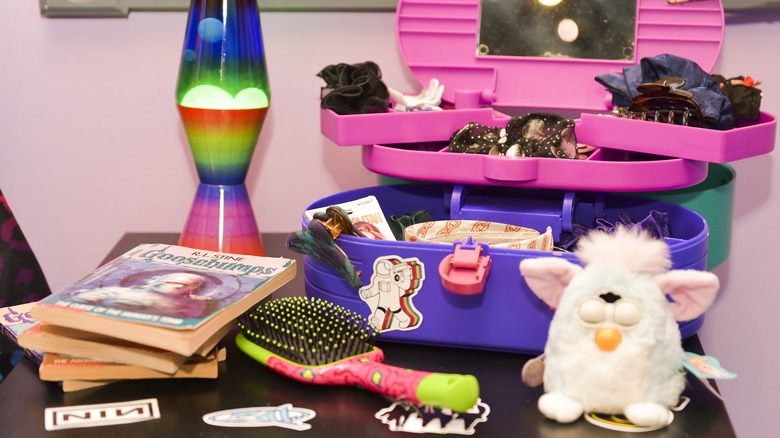Who Invented Furby?
Few things embody the freaky aesthetic of the late '90s like Furby. Anyone who was a kid back then (or a confused parent) might remember the shrieking, babbling fuzzball that took the world by storm. Produced first by Tiger Electronics and later by Hasbro, Furby was a virtual pet that blinked, saw light, and spoke its own language. It might sound creepy on paper, but it was a smash hit — selling tens of millions of units in dozens of colors before the fad fizzled out. And according to Bustle, it was a labor of love by toymakers David Hampton and Caleb Chung, and inventor Richard C. Levy.
Launched in 1998, Furby's weirdness was part of its appeal, at least at first. The toy's huge eyes and ears and birdlike beak were grotesque in an era where "gross" was cool when it came to kids toys. But while its uncanny ability to act like a living animal (albeit an alien-looking one) may have also played a role in its downfall, its innovative features and collectibility have enshrined it in a pantheon of classic '90s toys alongside Tickle Me Elmo and Beanie Babies.
Inspiration came from a digital pet
David Hampton was working at Mattel when he met Caleb Chung, and the two couldn't be more different. Bustle describes Hampton as a lifelong tinkerer who enlisted in the Navy after high school so that he could work in aviation electronics, an eight-year stint that earned him jobs in Silicon Valley. Chung grew up in a low-income family that constantly moved houses, but he graduated high school and had an unfettered imagination.
Hampton and Chung's ambitions and roots at Mattel would perfectly align when they attended the 1997 Toy Fair trade show in New York. On display was another virtual pet that got them thinking of new possibilities.
"That year, we saw Tamagotchis," said Chung in a 2014 interview. "We saw an opportunity, Dave and I, to improve the Tamagotchi. Because the idea of a play pattern that involved a living creature that you had to nurture, that was now."
Chung asked Hampton if he had any ideas, and Chung remembers his business partner saying, "I just want a little guy that will be my friend." Soon, they developed a prototype for "Furball," a toy that could outdo Tomagotchi.
Building a better 'Furball'
David Hampton and Caleb Chung's biggest gripe with Tamagotchi, their chief inspiration for Furby, was that users' pets were just images on a screen. Unlike a plush toy, Tamagotchi couldn't be physically touched or played with. But their "Furball" would be designed as a more tactile toy — a virtual pet that you could actually pet. Their prototype had bright colorful hair, soft ears, and big luscious eyelashes, all designed so that users could pat it and interact with it on an emotional level.
In the 2014 mini-documentary on Chung's Furby work, he explains how the development of the toy was a careful balance between fun, form factor, and cost. Chung wanted to reduce the number of motors inside Furby to just one, to make sure it was inexpensive to produce. The challenge of designing around that limitation "was like an exercise, it was like a haiku of the thing I'd like to make."
It took them a summer to make, after which they set about licensing the new toy. The famous "Furbish" language — a soup of global tongues and dialects — wasn't yet ready in the prototype. Instead, in demonstrations, Hampton and Chung would puppet the motorized toy and voice it in an approximation of how they thought "Furball" might behave as a finished product.
The rise and fall of Furby
Richard C. Levy was a film promoter and a principal architect of the WORLDNET satellite network. He was also a key player in garnering David Hampton and Caleb Chung a licensing deal with Tiger Electronics, later acquired by Hasbro. With the backing of a major toy company, the three inventors were able to turn "Furball" into the intelligent and noisy little gizmo named Furby. It debuted at the American International Toy Fair in 1998 and launched that October at the world-famous FAO Schwartz toy store, then located on Fifth Avenue in New York City. Bustle calculates the toy's rise in the millions: 1.8 million units sold in '98, 14 million in '99, 40 million by the dawn of the new millennium.
At just $35, Furby was a bonafide hit. But like its contemporaries, it was a fad that came crashing down to earth as soon as something newer hit the scene. Whether it was Webkinz, Pokémon, or something else entirely, Furby was buried by the next popular toy fad within a decade.
Furbys of the 21st century
Flagging sales didn't stop Hasbro from trying to reignite the Furby flame over the next 20 years. The Official Furby Wiki lists a number of spinoffs and revisions, including Furby Babies in 1999 — during peak Furby fandom — and a revision called Emoto-Tronic Furbys in 2005 (as well as Emoto-Tronic Furby Babies, naturally). The '05 Furbys were larger, used different materials for their beaks and feet, and lacked the light sensors of the original '98 Furby. The biggest change was in their mouths and speech recognition, with a new ability to be fed and respond to specific phrases. But it wasn't enough to bring Furby back from the dead.
In 2012, Hasbro rebooted Furby in a modern form much closer to its original source of inspiration. The 2012 Furby now had Tamagotchi-like personality development, LCD eyes, mobile app connectivity, and of course, a higher price tag at $54. Furby was now closer to the price of a brand new video game than a stuffed animal.
The Final Furby
After the 2012 rebooted Furby became a hit, Hasbro started releasing variations that sounded more like portable speakers than virtual pets. The Furby Party Rocker and Furby Boom offered a simpler and more complex Furby experience, respectively. Party Rocker was easier to raise, with set personalities closer to a classic Furby, while Furby Boom was an even more advanced version of the 2012 toy. Boom, for instance, could remember its own name. Better yet, the later released Furblings could interact with Furby Boom toys, almost in a child-parent relationship.
As of 2022, the latest and final Furby released was Furby Connect, which launched in 2016 alongside a similarly titled app. Now, users could watch videos online with their pets, and even hear Furby sing Kidz Bop classics. According to comments on the Official Furby Wiki, both the Connect toy and software were discontinued around 2019.
In an article titled "One-Hit Wonders," the Strong Museum of Play in New York identified Furby as a classic, if briefly popular, American toy. "Though you can still buy a Furby today," they wrote, "I think it's safe to say that Furby's popularity has fizzled, perhaps because the critters seem liable to wake up and chat your ear off at any moment."
